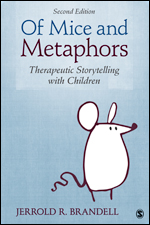Of Mice and Metaphors
Therapeutic Storytelling with Children
Second Edition
Jerrold R. Brandell - Wayne State University, USA
Jerrold R. Brandell - Wayne State University, USA
176 pages
| February, 2016
| SAGE Publications, Inc
Instant Access!
eBook
ISBN: 9781506305608
Paperback
ISBN: 9781506305592
$65.00
Instant Access!
eBook
ISBN: 9781506305608
Allegories, fables, myths, legends, and other time-honored forms of storytelling have been used since the beginning of recorded history to convey important values and moral precepts to the young. Storytelling comes naturally to children, and also offers them an unparalleled means through which they may express the fantasies, anxieties, and conflicts of their inner lives.
In Of Mice and Metaphors, Second Edition, psychoanalyst and child treatment specialist Jerrold R. Brandell introduces a variety of dynamic strategies for therapists to understand and incorporate a child’s own creative story-narrative into an organic and reciprocal treatment process leading to therapeutic recovery and healing. Engaging case histories encompassing a wide spectrum of childhood problems and emotional disorders are used to illustrate complex, effective strategies that include actual clients’ stories and the author’s response to their narratives.
In Of Mice and Metaphors, Second Edition, psychoanalyst and child treatment specialist Jerrold R. Brandell introduces a variety of dynamic strategies for therapists to understand and incorporate a child’s own creative story-narrative into an organic and reciprocal treatment process leading to therapeutic recovery and healing. Engaging case histories encompassing a wide spectrum of childhood problems and emotional disorders are used to illustrate complex, effective strategies that include actual clients’ stories and the author’s response to their narratives.
Available formats
ISBN: 9781506305608
eBook
Suggested Retail Price: $26.00
Bookstore Price: $20.80
ISBN: 9781506305608
eBook
Suggested Retail Price: $30.00
Bookstore Price: $24.00
ISBN: 9781506305608
eBook
Suggested Retail Price: $33.00
Bookstore Price: $26.40
ISBN: 9781506305608
eBook
Suggested Retail Price: $47.85
Bookstore Price: $38.28
ISBN: 9781506305592
Paperback
Suggested Retail Price: $65.00
Bookstore Price: $52.00
See what’s new to this edition by selecting the Features tab on this page. Should you need additional information or have questions regarding the HEOA information provided for this title, including what is new to this edition, please email sageheoa@sagepub.com. Please include your name, contact information, and the name of the title for which you would like more information. For information on the HEOA, please go to http://ed.gov/policy/highered/leg/hea08/index.html.
For assistance with your order: Please email us at textsales@sagepub.com or connect with your SAGE representative.
SAGE
2455 Teller Road
Thousand Oaks, CA 91320
www.sagepub.com
A Prefatory Note
Prologue
Children's Stories: An Overview of the Literature
What Is Reciprocal Storytelling?
When Is Reciprocal Storytelling Useful and with Which Patients?
Eliciting the Child's Story
The Lesson or Moral
Poststory Discussion
The Therapist's Role in the Storytelling Process
What Are the Most Important Components of Children's Stories?
Which Theoretical Frameworks Are Compatible with Reciprocal Storytelling?
The Case of Tony
Summary
Discussion Questions
The Case of Sean
The Case of Robert
The Case of David
The Case of Carl
Using Squiggle Drawings in Conjunction with Diagnostic Stories
The Case of Danny
The Case of Annie
The Case of Derek
Stories Used for Evaluative Purposes
Summary
Discussion Questions
Historical and Narrative Discourse: Theoretical Perspectives
Clinical Assessment in Child Psychotherapy: The Cultivation and Synthesis of "Data"
The Narrative Discourse in Child Psychotherapy
Autogenic Stories: Royal Road to the Child's Narrative
The Case of Jed
Summary
Discussion Questions
The Case of Sean, Revisited: Responding to an Environmental Crisis
The Case of Naima: Severe Separation Anxiety in a 7-Year-Old Transracial Adoptee
The Case of Roberta: Depletion Depression in a Biracial Child
Storytelling with a Borderline Child: Therapeutic Considerations
The Case of Harry
Summary
Discussion Questions
Treatment Considerations
The Case of Nathan
Summary
Discussion Questions
Historical and Contemporary Perspectives
The Case of Mattie: Illustration of a Selfobject Transference
Countertransference Phenomena
Summary
Discussion Questions
Pertinent History
Bruce’s Treatment Begins
"The Snake That Came Out of the Hole"
"The Ghost with a Conscience"
"The Boy Who Felt Like a Ghost"
"The Bird That Never Laughed"
Countertransference Themes in Bruce's Treatment
Conclusion and Further Reflections
Discussion Questions
The Case of John
Summary
Discussion Questions
Epilogue
Appendix
References
Index
About the Author
NEW TO THIS EDITION:
- Revised and expanded chapters throughout incorporate significant changes in the field of dynamic child treatment over the last 15 years.
- New clinical illustrations represent a wide range of presenting problems from venues such as family service, community mental health, and outpatient child psychiatry, and illustrate aspects of therapeutic communication with children through metaphors.
KEY FEATURES:
- Transcriptions of the actual stories told by children and reconstructions of specific therapeutic responses demonstrate how such techniques are actually used, lending additional clarity to clinical material.
- Specific information on how to use children’s projective stories in dynamic clinical assessment helps readers prepare to use strategies in their own clinical practice.
- Practical guidelines for identifying clients who are good candidates for storytelling include taking into account such factors as the child’s diagnosis, age, maturity, verbal ability, and resistance to engagement.
- Variations on the basic storytelling process range from non-reciprocal diagnostic techniques to stories used in conjunction with therapeutic games or other play techniques.
- Examples from the author’s case files illustrate storytelling with children suffering from attachment disorders, borderline disturbances, self-object disorders, and complex posttraumatic conditions.
- Chapter-ending discussion questions assist readers in discerning the most essential ideas and concepts.

